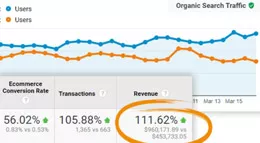10 mCommerce Design Guidelines to Convert Customers
Mobile commerce (mCommerce) continues to grow across all industries. If you haven’t updated your website for smartphone users, it’s time to create a valuable experience on the small screen. To get you started, we’ve compiled 10 mCommerce design principles to impress your customers and get them to convert.

A Few Stats on Mobile Usage
These statistics illustrate a clear trend towards increased reliance on smartphones for internet access, shopping and other activities, reflecting the growing importance of mobile technology in everyday life.
Now, let’s talk about 10 ways you can upgrade your web design to ensure you maximize the mobile experience for your shoppers.
1. Give Users the Power to Swipe, Pinch and Double-Tap
One of the great things about optimizing your mCommerce site is that you don’t have to reinvent the wheel. Mobile internet users already have an idea of how your website should work and what they expect from pages on the internet. All you have to do is think about what your customers are used to and make sure they have it.
A few easy examples of this are the swipe, zoom and double-tap options. In the mCommerce world, customers expect these functionalities when looking at product pages and reading about the items you offer. However, in a benchmark of 50 top US eCommerce sites by Baymard, only 40% actually offered that functionality to users.
Don’t try to change internet user behavior by requiring your site visitors to click on your images or load each individual photo. Think about how you browse the web and make sure your pages reflect that instinct.
2. Make Sure Each Section is Distinct
You might appreciate a minimalist design with light gray text on a white background, but your customers do not. Every design choice on your mobile device is more subtle than on your desktop and is more likely to confuse your customers. It’s better to go big and bold than to try blending everything together.
3. Optimize Keyboard Layouts for Easier Form Functions
The Baymard Institute also highlighted how the mobile device checkout process limits users. This may seem like a small optimization step, but it can significantly impact your overall usability and customer experience.
4. Let Users Scan Their Credit Cards or Pay With Wallets
Along with optimizing your forms, make it easy for customers to add their credit card information during the checkout process. Use the stored data and APIs that Apple and Android devices have to autofill credit card information or create options to scan credit cards for easy entry.
Also, consider enabling Apple Pay or PayPal to complete the transaction. This saves time and frustration over shoppers digging out their credit cards and squinting as they add each number into the tiny smartphone fields.
5. Remove Your Animated Carousel
Animated carousels might be visually appealing and they might look great on desktop devices, but they tend to confuse mobile users. Instead, add different blocks with information on your mCommerce homepage. Mobile users are scrollers. They’re used to scrolling down for more information. You may find that more people see your static banners through scrolling than they previously did with a carousel.
6. Remember Information if Something Goes Wrong
Mobile users already have lower conversion rates than customers on desktop and mobile. As of November 2023, the average mobile e-commerce conversion rate was reported to be 4.18%. This rate indicates that nearly one out of every 24 visits to an online store via a mobile device results in a conversion. If something goes wrong, your customers will likely bounce or head to their desktops to complete the purchase.
Few things are more frustrating online than submitting a form, only to be presented with an error message and a completely clean page. Your customers aren’t going to add their name, address, and credit information again just because they missed their credit security code the first time around.
7. Make Your mCommerce Guest Checkout Option Clear
There’s no doubt about it: your mCommerce website needs guest checkout options. According to Moovweb, 66% of the top 100 retail websites allow customers to check out as guests, preventing a drop in conversions from customers who don’t want to register with the company just to buy a product. Customers were 1.2x more likely to select guest checkout instead of creating an account, and guest users make up 53% of mobile website revenue on average.
Should you encourage your customers to create an account? Of course. This allows you to collect their information and send out personalized marketing messages in the future. However, enabling guest checkout can move uncertain customers across the finish line with ease.
That being said, make sure your guest checkout option is easy to see. Some mCommerce developers are so focused on converting customers into registered buyers that they hide the guest checkout button, frustrating users and causing them to bounce.
8. Guide Website Visitors to Your Category Bars
Just as customers are used to pinching and swiping, they also know to search for category pages to narrow their search results. A great example of this is Victoria’s Secret. On their mobile website, you can immediately choose between their main brand or PINK brand. From there, you can filter through the categories to easily find what you need.
As a bonus, the fonts change between the three categories, so the menu for Victoria Sport looks different from the PINK one. This clearly differentiates the sub-brands from each other, reducing confusion.
If you’re unsure whether or not your users are struggling to navigate your categories, test something new. Pit two designs against each other and run an A/B test to see which one your users prefer.
9. Improve Your On-Site Search Functions
Your customers turn to on-site search functions when they can’t find what they need and hope to reach the right products or information easily.
There’s a whole science to improving your mCommerce on-site search performance, and we encourage you to check out that article to make it easy for your mobile users to navigate your site – regardless of what they’re looking for.
10. Clearly Display Shipping Options
Shipping is a contentious battleground in the B2B eCommerce world. Companies need to charge it to cover their costs, but customers increasingly want to avoid paying it (or else they’ll take their business to Amazon).
If you offer free shipping, broadcast it loud and clear on your mobile site. Even if you charge your customers for shipping, clearly labeling what the costs will be can prepare your customers for the expense. It’s certainly better to let customers know about their shipping options instead of increasing the price by $10 when they reach the checkout page.

